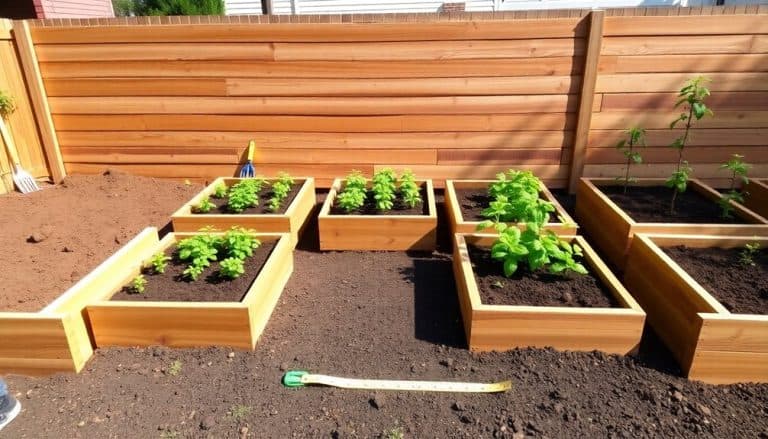This website contains affiliate links. Some products are gifted by the brand to test. As an Amazon Associate, I earn from qualifying purchases. The content on this website was created with the help of AI.
You’ll find companion planting essential for your organic garden because it creates a thriving ecosystem that works in harmony. By strategically pairing plants, you’re naturally deterring pests while attracting beneficial insects and pollinators. Plants like marigolds and basil act as natural pest controls, while flowering herbs draw helpful predatory insects. You’ll maximize your garden space through smart plant combinations and reduce weed problems with living ground covers. Companion planting also improves soil health through nitrogen-fixing relationships and diverse root systems. Understanding these plant partnerships opens the door to a more productive and sustainable garden.
Key Takeaways
- Natural pest control is achieved through strategic plant combinations that repel harmful insects while attracting beneficial predatory insects.
- Companion planting maximizes garden space by combining tall and short plants, reducing weed growth through dense plantings.
- Strategic placement of flowering companions enhances pollination rates and fruit production by attracting diverse pollinator species.
- Plant diversity improves soil health through natural nutrient cycling, with legumes fixing nitrogen and deep-rooted plants mining minerals.
- Companion planting creates resilient garden ecosystems by establishing beneficial relationships between plants, insects, and soil microorganisms.
Natural Pest Management
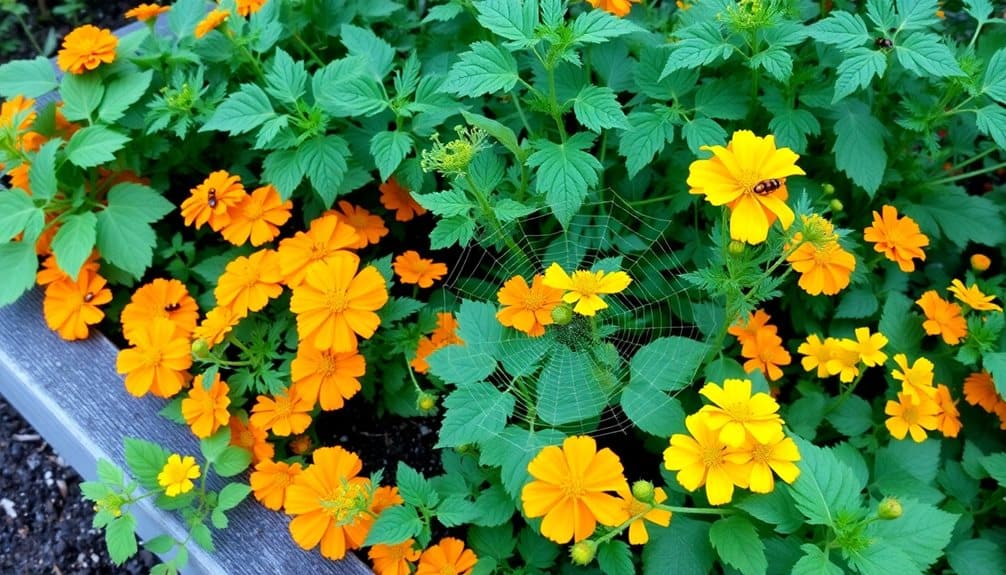
Anyone who’s tried organic gardening knows that managing pests without chemicals can be challenging. However, companion planting offers a natural solution by strategically placing plants that repel harmful insects while attracting beneficial ones. You’ll find that certain aromatic herbs like basil, mint, and marigolds act as natural deterrents for common garden pests.
By pairing your vegetables with these protective companions, you’re creating a natural defense system. Plant nasturtiums near your cucumbers to ward off squash bugs, or surround your tomatoes with basil to repel hornworms. You can also plant dill and fennel to attract beneficial insects like ladybugs and parasitic wasps, which prey on aphids and caterpillars.
Consider creating diverse plant communities that confuse pests through scent and visual camouflage. Interplanting strong-smelling herbs throughout your garden disrupts pest insects’ ability to locate their target crops. You’ll notice fewer pest problems when you incorporate companion plants like garlic, chives, and lavender among your vegetables. This natural approach not only protects your crops but also maintains the ecological balance essential for a thriving organic garden. For long-term success in pest management, explore our selection of effective natural solutions that complement your companion planting strategy.
Maximizing Garden Space
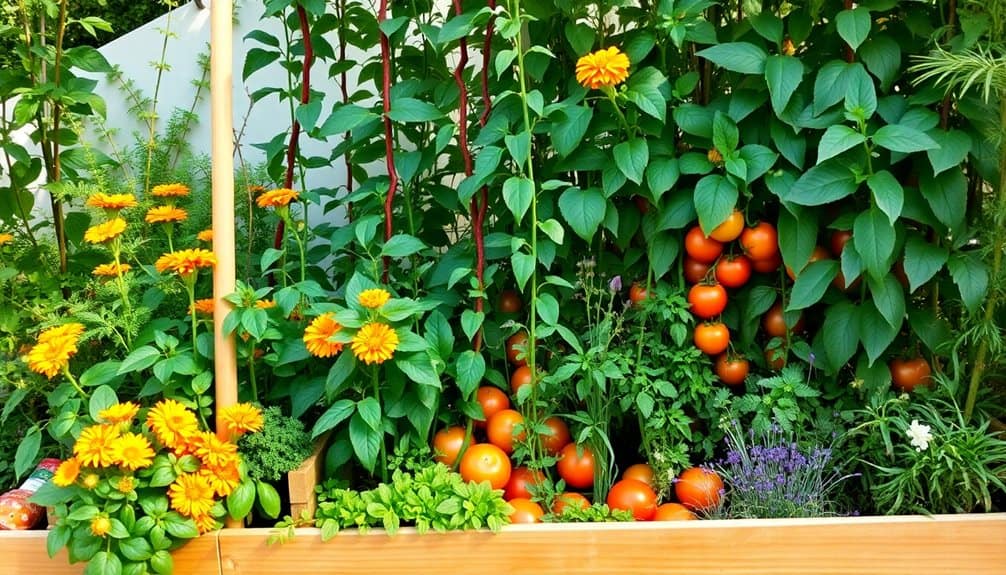
Three key strategies can help you maximize every inch of your garden space through companion planting. First, utilize vertical growing opportunities by pairing tall plants like pole beans or tomatoes with low-growing companions such as basil or carrots. The climbing plants provide natural support while the ground-level crops efficiently use the shaded space below. Second, interplant fast-growing crops with slower-maturing varieties. You’ll harvest quick crops like radishes or lettuce while your long-season vegetables are still developing. For optimal growing conditions, consider installing adjustable roof vents to help regulate temperature and airflow between your companion plants. Layer your plantings thoughtfully by considering root depths. Shallow-rooted herbs can thrive alongside deep-rooted vegetables without competing for nutrients. Plant shallow-rooted thyme or oregano near deeper-rooted peppers or eggpl
Enhanced Pollination Benefits
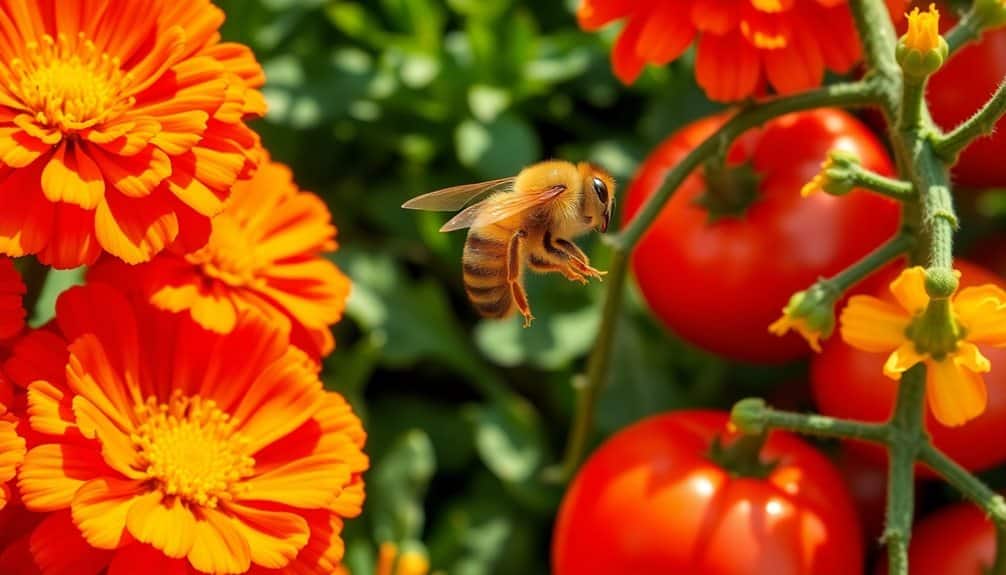
Strategic companion planting can dramatically boost pollination throughout your organic garden. By carefully positioning flowering plants alongside your vegetables and fruits, you’ll create an inviting habitat for essential pollinators like bees, butterflies, and beneficial insects. You’ll want to include plants with different bloom times to guarantee continuous pollinator activity from spring through fall.
Plant marigolds, zinnias, and borage near your tomatoes and squash to increase fruit set. These flowers’ bright colors and nectar-rich blooms will attract pollinators that’ll then visit your food crops. You can also interplant herbs like basil, oregano, and thyme, which produce small but abundant flowers that support native bee populations.
To maximize pollination benefits, you’ll need to maintain diversity in flower shapes and sizes. For example, combine flat-faced flowers like cosmos with tubular blooms like salvias. This variety accommodates different pollinator species with varying mouth parts and feeding habits. Don’t forget to include native flowering plants in your design – they’re especially effective at drawing local pollinators that have evolved alongside them. This integrated approach guarantees reliable pollination while reducing your dependence on manual pollination methods.
Having the right seed starting equipment will ensure your companion plants get a healthy head start before the growing season begins.
Soil Health and Nutrient Balance
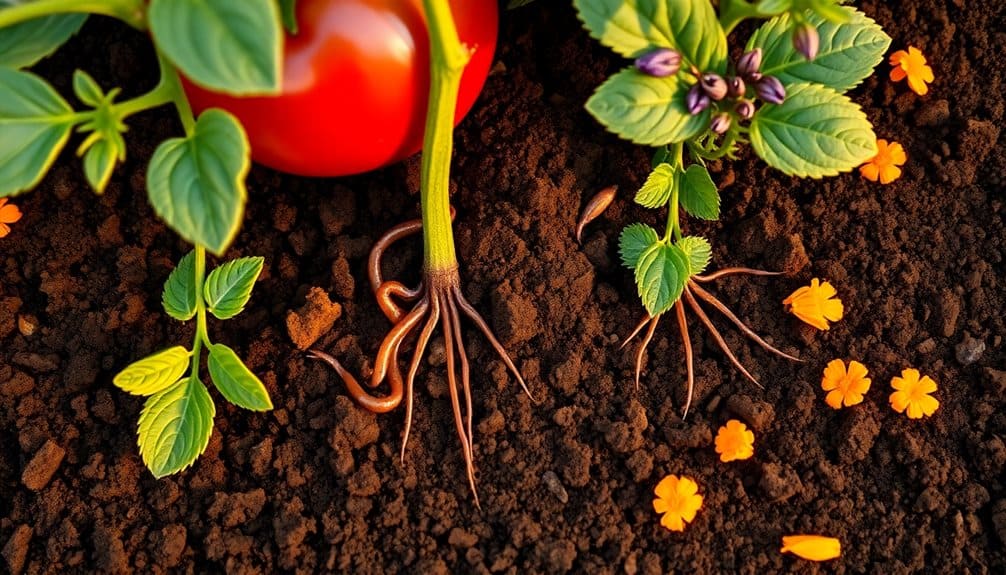
Maintaining robust soil health through companion planting creates a natural nutrient cycling system that benefits your entire garden ecosystem. When you pair nitrogen-fixing plants like legumes with heavy feeders such as corn or squash, you’ll create balanced nutrient exchanges in your soil. Legumes convert atmospheric nitrogen into a usable form, enriching the soil naturally without synthetic fertilizers.
You’ll find that deep-rooted plants like comfrey or yarrow mine minerals from lower soil layers, making nutrients available to shallow-rooted companions. These dynamic accumulators bring up calcium, potassium, and other essential minerals that would otherwise remain inaccessible. Plant diversity also supports beneficial soil microorganisms, enhancing organic matter decomposition and nutrient availability.
Strategic companion planting helps you manage soil pH levels naturally. For instance, you can plant acid-loving blueberries near pine trees, which create favorable soil conditions through their needle drop. By incorporating cover crops and living mulches into your companion planting scheme, you’ll protect soil structure, prevent erosion, and maintain ideal moisture levels. This integrated approach reduces your need for external inputs while building long-term soil fertility.
Plant Growth and Support
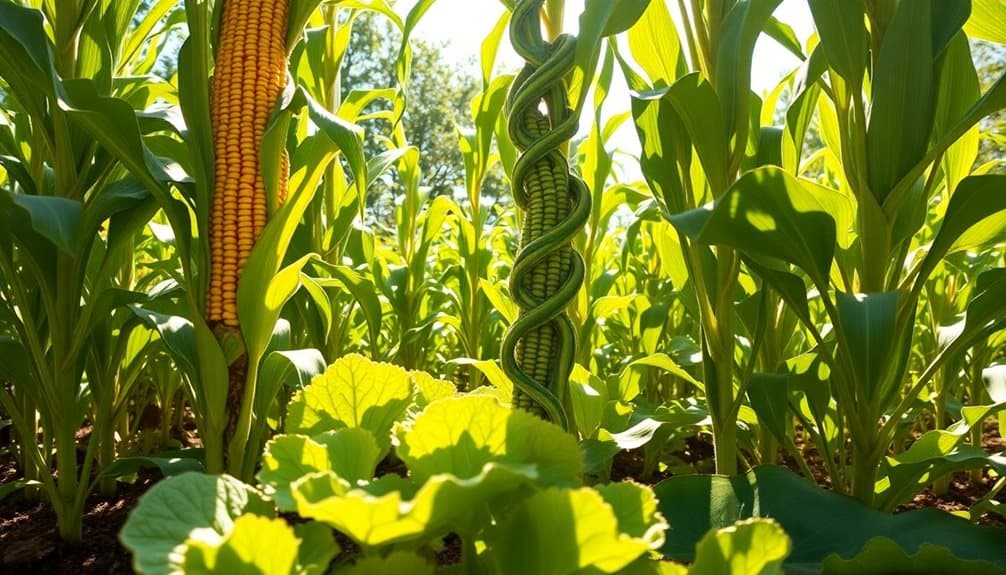
Beyond soil nutrition, the way plants physically interact creates natural support systems in your garden. Tall, sturdy plants like corn and sunflowers can serve as living trellises for climbing varieties such as pole beans and peas. You’ll save money on artificial supports while maximizing vertical growing space in your garden.
Strategic plant placement also provides essential shade and wind protection. Plant tall crops on the north side of shorter ones to prevent overshadowing, and use robust plants as windbreaks to shield delicate seedlings. You can create beneficial microclimates by grouping plants with similar height and support needs together.
Understanding growth patterns helps you plan better spacing. Shallow-rooted plants like lettuce work well beneath deeper-rooted vegetables, while sprawling crops like squash can serve as living mulch under tall plants. By layering your garden this way, you’ll optimize space usage and reduce competition for resources.
When you’re planning support systems, consider the mature size of each plant and its growth habit. This forward-thinking approach guarantees your garden remains organized and productive throughout the growing season while maintaining natural support structures. For maximum stability when using plants as supports, ensure they can handle up to 66 pounds of weight from climbing varieties, similar to metal garden tool organizers.
Weed Control Strategies
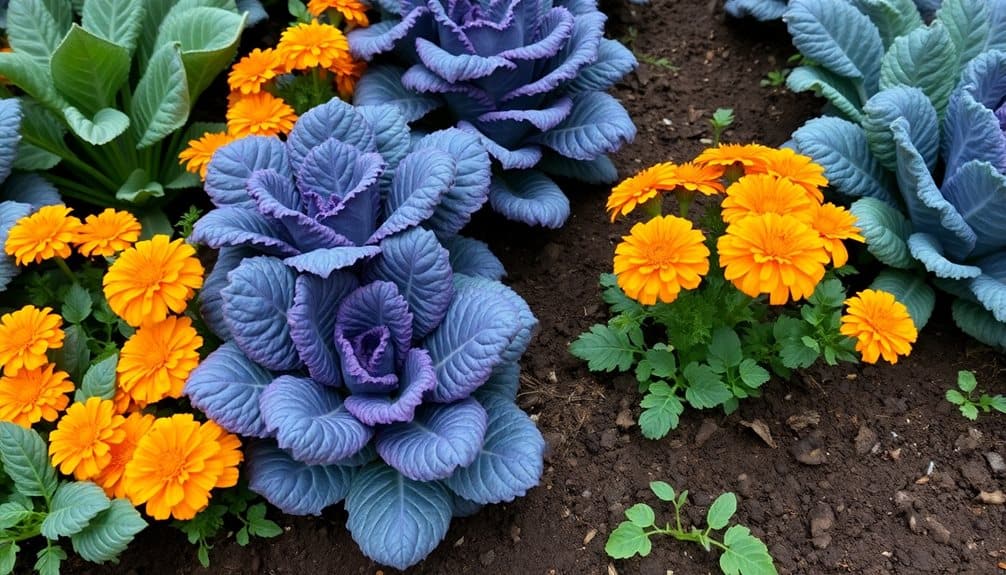
One of the most effective weed control methods in companion planting comes from selecting dense-growing plants that naturally suppress unwanted growth. You’ll find that low-growing herbs like thyme and oregano create living mulch that blocks weed seeds from germinating while maximizing your garden space. Similarly, spreading plants such as sweet potatoes and squash shade the soil with their broad leaves, naturally preventing weed establishment.
You can strengthen your weed control strategy by implementing companion plant combinations that occupy different vertical spaces. Plant tall, upright crops like corn or sunflowers alongside sprawling beans or peas. This multi-level approach guarantees that weeds don’t find room to establish themselves between your cultivated plants.
For ideal weed suppression, you’ll want to space your companion plants closely enough to create shade but not so tightly that they compete for nutrients. Consider using fast-growing companions like buckwheat or clover as temporary ground covers between slower-developing crops. These plants won’t just control weeds—they’ll also improve your soil structure and add valuable organic matter when turned under as green manure.
Beneficial Insect Attraction

While managing weeds through companion planting creates a healthier garden, attracting beneficial insects takes your organic growing strategy to the next level. By incorporating specific flowering plants, you’ll create a habitat that draws in natural predators like ladybugs, praying mantises, and parasitic wasps – nature’s own pest control squad.
You can attract these helpful insects by planting umbel-shaped flowers like dill, fennel, and Queen Anne’s lace, which provide ideal landing pads and nectar sources. Composite flowers such as marigolds, zinnias, and cosmos will bring in hover flies and parasitic wasps that feast on aphids and caterpillars. Don’t forget to include herbs like oregano, thyme, and mint, which not only enhance your cooking but also serve as micro-habitats for beneficial insects.
To maintain a steady population of helpful bugs, you’ll want to guarantee continuous blooming throughout the growing season. Plant spring flowers like alyssum and calendula, summer bloomers including borage and bee balm, and fall-flowering plants such as asters and goldenrod. This succession of blooms keeps your beneficial insect army well-fed and actively patrolling your garden against harmful pests.
Creating Biodiversity in Gardens
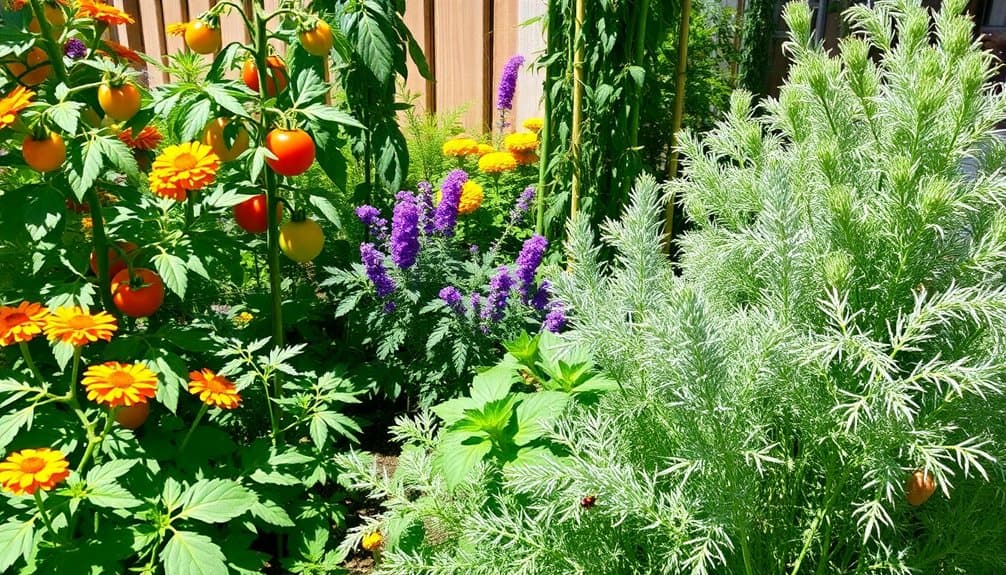
From the ground up, creating biodiversity in your garden strengthens its natural resilience and promotes a thriving ecosystem. You’ll enhance soil health by incorporating different plant families with varying root depths and nutrient requirements. This diversity helps prevent soil depletion and creates multiple layers of vegetation that support different species.
Mix annuals with perennials, herbs with vegetables, and flowering plants with food crops. You can maximize vertical space by combining climbing plants with low-growing varieties, while ground covers protect soil moisture and suppress weeds. Include native plants that have adapted to local conditions and naturally support regional wildlife.
Don’t limit yourself to plants alone – incorporate natural features like rock piles, water sources, and woody debris that provide habitat for beneficial organisms. You’ll create microhabitats that support predatory insects, pollinators, and soil microorganisms. Layer your garden with different heights, textures, and blooming periods to guarantee year-round resources for wildlife.
Remember that a biodiverse garden isn’t just about quantity – it’s about creating functional relationships between species that support each other’s growth and survival. Keep gardening bags nearby while working to efficiently collect weeds and maintain your diverse garden spaces.
Frequently Asked Questions
Can Companion Planting Help Regulate Temperature and Moisture Levels in Garden Beds?
Yes, you’ll find companion planting highly effective for temperature and moisture control in your garden beds. Tall plants can shield shorter ones from intense sun and wind, while sprawling ground covers act as living mulch to retain soil moisture. You’ll create beneficial microclimates when you combine plants of different heights and growth habits, helping maintain ideal growing conditions throughout your garden space.
How Long Does It Take to See Benefits From Companion Planting?
You’ll notice some companion planting benefits within a single growing season, while others take longer to develop. Quick results include pest control within 2-4 weeks as beneficial insects arrive, and improved pollination once flowering begins. Soil enhancement benefits typically emerge after 3-6 months, while long-term advantages like improved soil structure and biodiversity become evident over multiple growing seasons, usually 1-2 years.
Is Companion Planting More Effective in Raised Beds or In-Ground Gardens?
Studies show that companion planting can increase yields by up to 25% in both raised beds and in-ground gardens. You’ll find companion planting works effectively in both settings, but raised beds offer better control over soil conditions and spacing. In-ground gardens, however, allow for deeper root systems and natural soil ecosystems. Your choice should depend on your specific plants’ needs and your garden’s existing conditions.
Should Companion Plants Be Rotated Annually Like Regular Crops?
Yes, you should rotate your companion plants along with your main crops annually. This practice helps maintain soil health, prevent pest buildup, and reduce disease pressure. When you’re planning your rotation schedule, consider moving entire plant communities together to preserve their beneficial relationships. You’ll get better results if you keep complementary plants paired while shifting them to different garden areas each season.
Can Companion Planting Help Prevent Cross-Pollination Between Different Vegetable Varieties?
While companion planting won’t completely prevent cross-pollination, you can use it strategically to create natural barriers between different vegetable varieties. Tall plants like sunflowers, corn, or pole beans can act as physical screens between varieties you want to keep pure. You’ll need to maintain proper spacing between different varieties and consider wind patterns, as pollen can travel significant distances through air currents.


